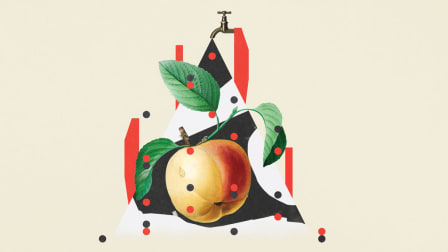An Easy Way to Remove Pesticides
A new study of apples finds baking soda may clean the fruit better than other washing methods

If you’re an apple lover, then fall is the time of year for you. But unless you buy organic apples, you might be concerned about pesticides that may be on the skin of the fruit.
Experimenting on Apples
To see how effective different washing methods were at removing pesticides, He's team purchased organic Gala apples (a popular variety) and then treated them with two pesticides that are commonly used on apples, one of which is designed to penetrate into the fruit. Then, the researchers washed different groups of apples in the bleach solution used in commercial processing. The researchers also washed the apples with a baking-soda and water solution, as well as with plain water.
“One thing that surprised us was how long it took to wash the pesticides away,” He said. Submerging apples in a baking soda solution for two minutes removed more pesticides than a two-minute soak in the bleach solution, or two minutes of rinsing in running tap water. But it took 12 to 15 minutes in the baking soda solution to completely get rid of the pesticides used in this study.
He points out that dozens of pesticides may be used in apple production, and the research team only looked at two. And no matter how thoroughly you clean your apples, you may not be able to remove all the chemicals, because some may penetrate more deeply into the fruit, depending on which pesticides they are and when they were applied.
“The effect of washing is not going to be consistent across all pesticides and probably not across all fruit and vegetable items,” says Cynthia Curl, Ph.D., assistant professor of community and environmental health at Boise State University, who wasn’t involved with the study.
Still, “It’s good to hear that something as simple and common as sodium bicarbonate—baking soda—is effective at removing some pesticides,” says James Rogers, Ph.D., Director of Food Safety and Research at Consumer Reports.
Make Produce Safer
Buying produce labeled USDA Organic is the best way to reduce your exposure to pesticides in produce, because organic crops are grown without the use of synthetic pesticides. Some types of conventionally-grown produce are more likely to have high levels of pesticide residues than others. Consumer Reports has compiled this guide.
You should also wash your produce before you eat it, by rubbing it under running water (or scrubbing if it has a tough skin). Rogers suggests that you do so as soon as you bring it home. The longer pesticides sit on fruits and vegetables, the deeper they’re absorbed, and the harder it is to remove them, he says. (Note that this may not be practical for delicate produce, such as berries or mushrooms, because washing them too far ahead of eating them may speed spoilage.)
If you want to take an extra step, consider submerging your produce in a solution of one teaspoon of baking soda and two cups of water for two minutes or more (the longer you soak, the more chemicals you get rid of), says He. Rinse in tap water again before eating.




















